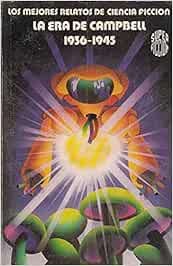
Original language: English
Original title: The history of the Science Fiction Magazine (1936 – 1945)
Translation: Jordi Arbonés
Year of publication: 1975
Valuation: Recommended for fans
Another science fiction anthology? Well, why not? It surely won’t be the last.
This is a type of literature very given to anthology. The short story is a type of format that adapts very well to the genre, with the necessary characteristics: an idea, a setting, the essential characters and the plot unfolds. There is no more, we don’t need it. Neither secondary, nor adjacent plots, nor digressions: we leave that for the long, more conventional novel.
This specific anthology refers to the so-called Golden Age of science fiction, when the genre began to be modeled as what we know today and the US market began to fill with specialized pulp magazines, in which great writers began to publish their first stories: Sturgeon, Asimov, Clarke, Ron Hubbard…
The Campbell of the title, John Campbell, does not refer to any writer but to an editor of several of those magazines who, apparently, thanks to great instinct, was something like King Midas of the genre.
The first volume has an extensive monograph of several dozen pages where all his exploits are mentioned, as well as the existing magazines, their duration and length, the pseudonyms of the most prolific authors, payment methods, some internal comics… Surely all very interesting for those who are really involved in the world: my hobby is not enough, I have read it, but, as a science fiction fan, without further aspirations, I could have skipped it perfectly. Only recommended for the most recalcitrant fans.
What interests us, the stories: This is where the good comes and the main reason why I have decided to read this anthology. If we look at the title of the volume (1936 – 1945) it will not be difficult to discern the reason for this historical extract: The Second World War, with all that it entails (as far as we are concerned in this review, crisis of the role and call to the weapons of young writers), put an end to almost all pulp magazines and a way of understanding the genre, relegating a more or less brilliant generation of authors to oblivion. Selected excerpts from his work are what the two volumes present to us here and the reason for the anthology.
As it could not be otherwise, classic themes such as time travel, the threat of a post-Cold War Earth (when the war had not yet ended) or the transmigration of consciousness are the foundations of the stories that make up the work. Several of them also suffer from classic flaws of the genre: Manichaeism, mad geniuses and perfect heroes, anthropocentrism, short-sighted perspective, deus ex machina… the early nature of the stories (some more than a hundred years old already) allows me to go through I stopped these errors, knowing in advance what I was going to find.
Names unknown to me such as Weinbaum (prematurely deceased), Fearn, Leister or Williamson become revelations and leave details of their quality: sometimes, the reader assuming in a story a silly, illogical or predictable ending, they give us a lesson in rationality with an unexpected twist. They may be old, but they are not naive. New authors to enjoy, without a doubt.
There is one story that stands out from the others, both in quality and length, and in itself would justify the acquisition and reading of these volumes: I am talking about Four-Sided Triangle, by Temple. In this work from the 1930s, there is speculation about human cloning, the ethical implications and emotional relationships that this would entail, and, keeping an eye on the information, a clone named Dolly appears, like the sheep. I have investigated whether the origin of the animal’s name came from this story, but it seems that it is just a coincidence. It is seen that the germ of Dolly the sheep came from a mammary gland, and the researchers, when thinking about these glands, could not think of others more protuberant than those of Dolly Parton. Anyway. I preferred my version of science fiction, but reality is sometimes more prosaic and, above all, more boring.
Another inevitable point in an anthology and any compilation is the variety of level: along with some stories that, today, can be read without any problem (disquisitions on eternity and probabilistics, for example), there are others much more blushing, both by theme and by treatment of characters (especially female), a point of the time that could clearly be improved.
Summary? Recommended for fans of the genre, it doesn’t go beyond that.
Source: https://unlibroaldia.blogspot.com/2024/01/michael-ashley-la-era-de-campbell-1936.html


